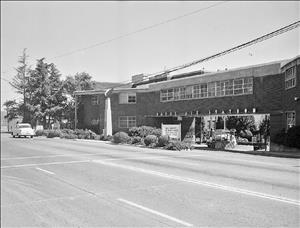On December 26, 1975, three elected officials, Senator Warren G. Magnuson (1905-1989), Seattle Mayor Wes Uhlman (b. 1935), and Seattle City Councilwoman Jeanette Williams (1914-2008) plant a ceremonial tree dedicating Sand Point Park (later renamed for Magnuson). The ceremony, taking place in the pouring rain, culminates a five-year struggle over the use of the park, a former piece of U.S. Navy property in far northeast Seattle. During this struggle, proponents of preserving its previous use as an airfield were pitted against neighborhood interests and elected officials including Magnuson and Uhlman who wanted a more people-friendly environment.
The U.S. Navy deactivated the Naval Air Station at Sand Point on June 30, 1970, with the aviation facilities to become surplus. On March 24, 1971, the National Oceanic and Atmospheric Administration (NOAA) announced that it wanted to locate its Western headquarters at Sand Point. In August 1973, the General Services Administration (GSA), the federal agency in charge of disbursing the surplus property, suggest a three-way, multiple use split of the property, including aviation, park, and NOAA.
Aviation Out
Magnuson led the charge against the aviation use, amending the funding bill for the General Services Administration. As a result, the GSA agreed to a two-way split on February 4, 1974 -- 212 acres for park and 100 acres for NOAA.
The aviation proponents weren't through yet however. On March 19, 1974, they released a poll showing support for an airstrip at Sand Point. On the following day, they launched an initiative campaign. King County voters first supported the airfield by a narrow margin in an advisory ballot on September 10, 1974. However, on November 5, 1974, voters in Seattle decided in a 3-2 vote to ban the aviation usage.
Court battles continued for a number of years. On December 26, 1975, the city formally took title to the 195.6 acres of Sand Point Park. Challenges persisted but they were unsuccessful.
Absolutely Beautiful
At the tree-planting ceremony, Magnuson said the new park was the largest piece of federal property ever deeded to a city and commented, "no city became great with an airport in the middle of it." Uhlman, who had once said that he would stand on the 5,000-foot Sand Point runway to keep planes out, said it was "an absolutely beautiful day," despite the downpour and gale in which he stood. Williams heralded "the great park this is going to be."

